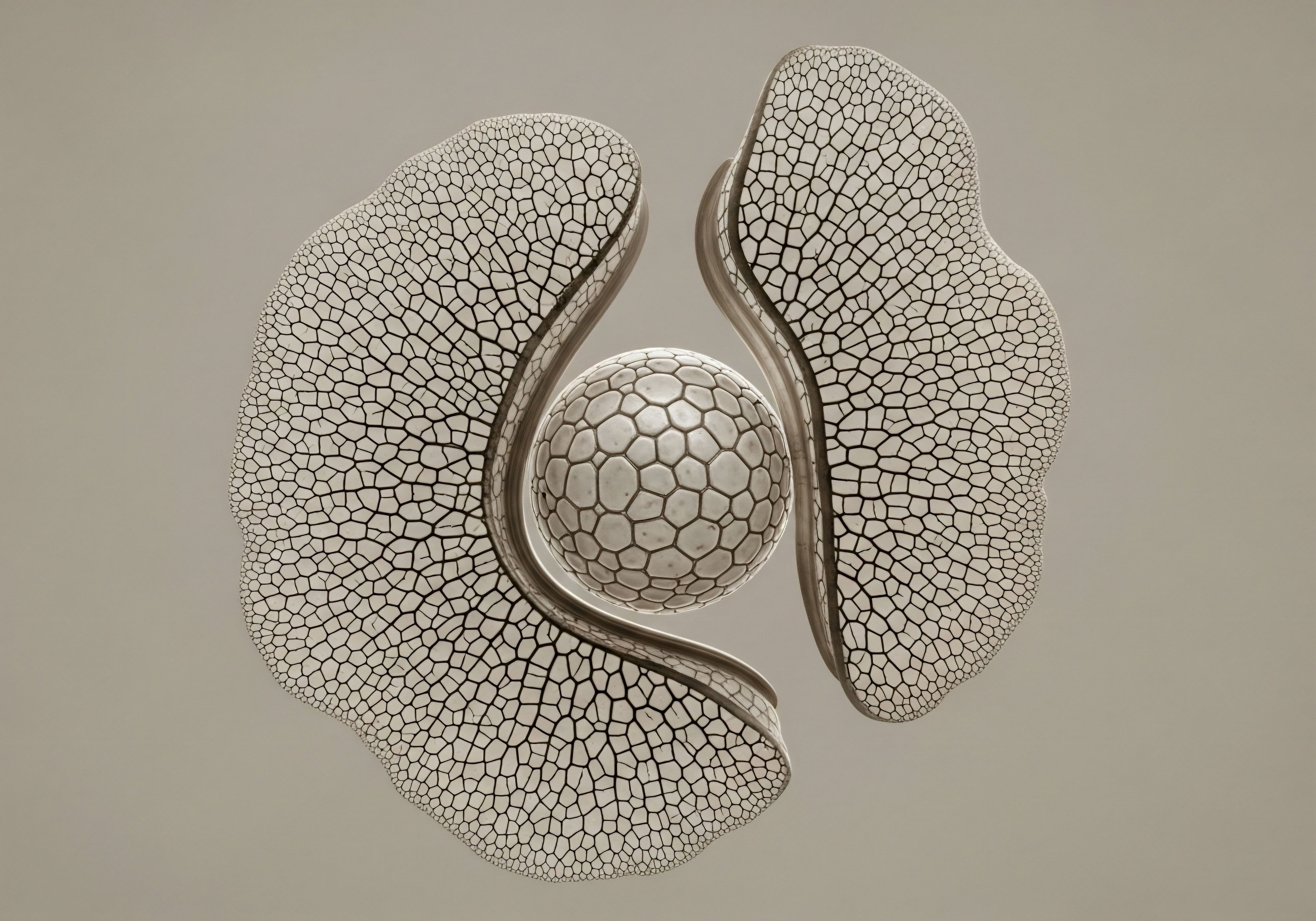

The Signal and the Static
Human performance is a function of biological communication. Your body operates on a network of chemical messengers ∞ hormones ∞ that issue directives for growth, energy utilization, mood, and cognitive function. Unrivaled performance is the result of these signals being clear, powerful, and precise. The degradation of performance over time is the predictable consequence of these signals becoming weak, distorted, or overwhelmed by metabolic static.

The Slow Decay of Biological Authority
Beginning around the third decade of life, the endocrine system’s output begins a gradual, inexorable decline. This is not a single event, but a system-wide reduction in signal strength. The production of key hormones like testosterone, dehydroepiandroderone (DHEA), and growth hormone (GH) attenuates, leading to a diminished release of Insulin-like Growth Factor 1 (IGF-1).
This process is the biological equivalent of a slow, creeping signal loss. The commands that once dictated rapid recovery, lean tissue maintenance, and sharp mental acuity lose their authority. The central control mechanisms in the hypothalamus and pituitary gland become less sensitive, disrupting the feedback loops that maintain hormonal equilibrium. This results in systemic dysregulation, where the entire network becomes less efficient.

Consequences of Signal Loss
The tangible effects of this hormonal decline are frequently misattributed to the abstract concept of ‘aging’. They are specific, physiological events. A decrease in testosterone is directly linked to reduced muscle mass, lower bone density, and diminished motivation. The decline in growth hormone and IGF-1 correlates with increased fat accumulation, particularly visceral adipose tissue, and slower recovery from physical exertion.
On a cellular level, brain glucose metabolism declines, contributing to cognitive slowdowns and a loss of mental sharpness. The system is no longer receiving the clear, potent directives required for high-output living.
The gradual and progressive age-related decline in hormone production and action has a detrimental impact on human health by increasing risk for chronic disease and reducing life span.


Systematic Endocrine Upgrades
Addressing hormonal decline is a matter of systematic intervention. It involves restoring the primary signals and introducing precise directives to recalibrate cellular function. This is an engineering problem that requires targeted inputs to restore system integrity and enhance its operational capacity. The goal is to move beyond passive acceptance of degradation and engage in active, precise management of your internal chemistry.

Restoring the Primary Signal
The foundational intervention is the restoration of primary androgenic and growth signals to youthful, optimal levels. This re-establishes the baseline authority of the endocrine system, allowing all subsequent processes to function from a position of strength.
- Testosterone Replacement Therapy (TRT): TRT is the process of reintroducing the body’s primary androgenic signal. By administering bioidentical testosterone, the therapy restores physiological concentrations, directly counteracting the signal decay of andropause. This re-establishes the commands for maintaining muscle mass, bone density, red blood cell production, and cognitive drive.
- Growth Hormone Axis Stimulation: Instead of direct GH administration, a more sophisticated approach involves using peptides like Sermorelin or Ipamorelin. These molecules, known as secretagogues, signal the pituitary gland to produce and release its own growth hormone in a natural, pulsatile manner. This restores the signal that stimulates liver IGF-1 production, which is instrumental in cellular repair, tissue regeneration, and metabolic health.

Targeted Cellular Directives with Peptides
Peptides are short-chain amino acids that act as highly specific signaling molecules. They are the tactical agents of a hormonal optimization strategy, delivering precise instructions to targeted systems for repair, recovery, and function.
These interventions represent a shift from a reactive to a proactive stance on biological performance. They are precise tools for system recalibration.
| Agent Class | Primary Mechanism | Performance Outcome |
|---|---|---|
| Androgens (Testosterone) | Binds to androgen receptors | Increased muscle protein synthesis, enhanced libido and drive, improved bone density |
| GH Secretagogues (Sermorelin) | Stimulates pituitary GH release | Improved recovery, reduced body fat, enhanced tissue repair |
| Repair Peptides (BPC-157) | Promotes angiogenesis and cellular repair | Accelerated recovery from injury, reduced inflammation |
| Metabolic Peptides (Tesofensine) | Modulates neurotransmitters for satiety | Appetite regulation, fat loss support |


The Performance Realization Timeline
Hormonal optimization is a strategic process with a predictable timeline of effects. The body responds to these new signals in a cascading sequence, from immediate subjective changes to profound long-term physiological restructuring. Understanding this timeline is essential for managing expectations and tracking progress with objective data.

Phase One Initial System Response
The first one to three months are characterized by the most noticeable subjective shifts as the body’s systems recognize and respond to the restored hormonal signals.
- Weeks 1-4: The earliest effects are often neurological and metabolic. Users typically report improvements in sleep quality, mood stability, and cognitive clarity. A distinct increase in motivation and general sense of well-being is common as testosterone begins to saturate tissues. Libido often sees a rapid and significant return.
- Weeks 4-12: Physical changes become more apparent. An increase in energy levels during workouts and improved recovery capacity are hallmarks of this phase. The body’s response to training becomes more efficient, with noticeable improvements in strength and endurance. Water retention may fluctuate initially as the body adapts to the new hormonal environment.

Phase Two Deep Physiological Adaptation
From three to twelve months, the effects of optimization compound, leading to significant and measurable changes in body composition and performance metrics.
- Months 3-6: This period is defined by changes in body composition. A measurable increase in lean muscle mass and a corresponding decrease in body fat, particularly visceral fat, become evident. Strength gains in the gym become more consistent and pronounced. Blood work will confirm hormonal levels are within the optimal therapeutic range.
- Months 6-12+: Long-term benefits manifest. Bone density improves, and markers of systemic inflammation may decrease. The cumulative effect of improved recovery, higher energy output, and enhanced protein synthesis results in a sustained high-performance state. This phase is about solidifying the gains and fine-tuning protocols based on ongoing biomarker analysis.
In men, overtraining can lower testosterone levels, resulting in reduced strength and energy. In women, it may disrupt cycles or cause amenorrhea, often tied to low estrogen and energy intake.

The Deliberate Biological Future
The human body is a dynamic system, not a static entity in managed decline. The principles of hormone mastery are an assertion of agency over this system. It is the application of precise, evidence-based inputs to elicit a desired, high-performance output.
This is the future of personal capability ∞ a deliberate and systematic engagement with the chemistry of vitality itself. It is the decision to become the architect of your own biology, rather than a passive observer of its decay.



